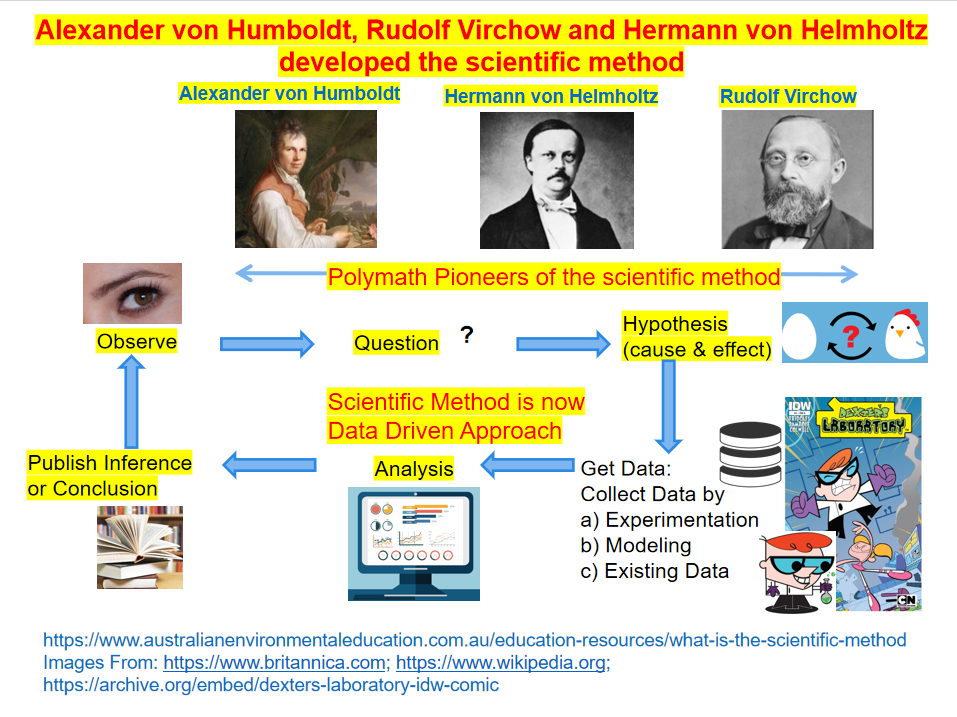Articles
https://fairwissenschaft.co.uk/articles-humanities
https://fairwissenschaft.co.uk/articles-science
fairwissenschaft-articles:
Articles will include TOPICS from science and humanities knowledge domains curated by me. This will include my review of it to capture essence of scientific method and what it means to be a logician in science and humanities. The goal is to satisfy and develop desire to learn and desire to solve problems, referred to as ‘Lernbegierde’ and ‘Problemlösungswunsch’, respectively in German. This exclusive content will be available only on my website, but you are free to share it on social media. Thank you.


When it comes to the scientific method, the Germans, Hermann von Helmholtz, Rudolf Virchow, and Alexander von Humboldt developed it. Their methods are still used today by knowledge workers across knowledge domains, i.e., “Wissenschaft” (science and arts/philosophy education and research). In today’s age of big data and AI, the scientific method is no longer limited to the sciences of chemistry, biology, and physics, where experiments are done in labs to get measurements—natural phenomenon link. It has expanded to art/philosophy domains like literature, where we now use natural language processing (NLP) to get data about the word-emotion link, psychiatry where we use fMRI and genomics for getting data about the gene-emotion link, and economics to get data about the profit-emotion (customer emotion) link. So, the “scientific method” has now been christened as a “data-driven approach.” Surely, Alexander von Humboldt’s approach to doing science through observation of surrounding nature (world and universe) may seem apparently different from Hermann von Helmholtz’s approach to do science through experimentation. But in reality, Rudolf Virchow and Hermann von Helmholtz would have first observed surrounding nature to come up with hypotheses and experiments, not to mention they would then observe the experimental results to draw conclusions (inferences); this constitutes the experimental approach to science that we call the scientific method. Alexander von Humboldt, who used an observational approach to science, saw Hermann von Helmholtz’s experimental approach to science as a logical final step towards further development of the scientific method as we know it today. So, Alexander von Humboldt helped Hermann von Helmholtz secure a position and funding so that Hermann von Helmholtz could continue his scientific work. Without Alexander von Humboldt’s intervention, whereby he took Hermann von Helmholtz out of the Prussian army and secured him a research position, Hermann von Helmholtz would probably have remained just an army physician instead of developing the scientific method. Let me explain.
1) Rudolf Virchow: Virchow was a pioneer in cellular pathology, emphasizing that diseases originate at the cellular level. He improved autopsy methods, leading to better disease diagnosis, and authored “Cellular Pathology,” which laid the groundwork for modern pathology. Rudolf Virchow’s method of doing science was based on detailed observation of patients and their symptoms, leading to precise diagnoses. His work was observational and experiments on dead bodies, as experimentation on live patients was not feasible because as doctor he was suppose to cure them could not risk harm by experimentation.
2) Alexander von Humboldt: Humboldt made significant contributions to plant biogeography, climatology, and oceanography. He explored uncharted territories, collected vast amounts of data, and his holistic approach to science fundamentally altered fields like ecology and geoscience. Alexander von Humboldt’s method of doing science, was based on meticulous observation of nature during his explorations, which enabled him to gather extensive data and develop a comprehensive understanding of the natural world.
3)Herman von Helmholtz: Helmholtz contributed to thermodynamics, electrodynamics, and ophthalmology. He formulated the conservation of energy principle, invented the ophthalmoscope, and his empirical and mathematical approach set high standards for scientific research. Herman von Helmholtz’s method of doing science involved observation followed by rigorous experimentation and mathematical analysis to validate his observations and theories.
4) The methods of Humboldt, Helmholtz, and Virchow, combining observation, hypothesis formulation, and experimentation, contributed to the development of what we now recognize as the scientific method.
4a) The scientific method is a systematic process for gathering knowledge and testing scientific hypotheses. It involves making observations, forming a hypothesis, conducting experiments, analyzing the results, and drawing conclusions.
4b) A data-driven approach emphasizes the collection and analysis of data to guide decision-making and hypothesis testing. It relies on empirical evidence and statistical analysis to draw conclusions.
4c) Both approaches rely on empirical evidence and aim to understand phenomena through analysis. The scientific method is a broader framework that includes hypothesis formulation and testing, while a data-driven approach focuses more on the analysis of existing data sets.
4d) By generating new data based on specific research questions, a data-driven approach can align with the scientific method. This hypothesis-driven “data science approach” can be applied across various fields, ensuring that analysis is guided by clear questions and hypotheses, much like the scientific method.
4e) Indeed, this would make “data driven approach” and “scientific method” synonymous and consistent with FAIR scientific framework (Findable, Accessible, Interoperable and Reusable) akin to Alexander von Humboldt, Rudolf Virchow and Hermann von Helmholtz’s “wissenschaft” method, rather “fairwissenschaft” (also name of my labor of love i.e. leisure knowledge work in progress #travailDamour #fairwissenschaft).
References:
- Helmholtz: A Life in Science by David Cahan | Goodreads | https://www.goodreads.com/book/show/36217451-helmholtz
- Genies – das Vermächtnis von Virchow und Helmholtz (RBB Talking Science) | Listen Notes | https://www.listennotes.com/podcasts/wissenschaft-auf/genies-das-verm%C3%A4chtnis-von-YdGeB-0Ruhn
- Hermann von Helmholtz: Master of Scientific Fields|Philosopher Biography | Youtube | https://youtu.be/r4dET4OZjcU
- The polymath with a sense of practice. Our namesake: Hermann von Helmholtz (1821-1894) was one of the last true polymaths | Helmholtz Berlin Germany EU | https://www.helmholtz.de/en/about-us/who-we-are/history/hermann-von-helmholtz
- Hermann von Helmholtz German scientist and philosopher #Britannica | https://www.britannica.com/biography/Hermann-von-Helmholtz
- Rousseau, G. History: Hermann von Helmholtz A polymath rediscovered. Nature 467, 1039–1040 (2010) | https://www.nature.com/articles/4671039a
- Alexander von Humboldt’s Trail | DW Documentary | https://youtube.com/playlist?list=PL7Cd9DgW3o63TqYqaiQS8yugiQxrj-kiL
- Alexander von Humboldt | https://www.britannica.com/biography/Alexander-von-Humboldt
- The Invention of Nature: The Adventures of Alexander von Humboldt, the Lost Hero of Science by Andrea Wulf – review | https://www.theguardian.com/books/2015/nov/13/the-invention-of-nature-the-adventures-of-alexander-von-humboldt-andrea-wulf-review
- COMPLEXITY: Physics of Life Podcast episode Andrea Wulf on The Invention of Nature, Part 1: Humboldt’s Naturegemälde | https://www.podbean.com/media/share/dir-j3qmx-e7e846b
- Alexander von Humboldt: Galvanism, Animal Electricity, and Self-Experimentation Part 2: The Electric Eel, Animal Electricity, and Later Years: Journal of the History of the Neurosciences: Vol 22 , No 4 | https://www.tandfonline.com/doi/full/10.1080/0964704X.2012.732728
- The vision of Helmholtz | Wade | https://www.tandfonline.com/doi/full/10.1080/0964704X.2021.1904182
- ‘BIG DATA’ AND ALEXANDER VON HUMBOLDT’S APPROACH TO SCIENCE – Grana‐Behrens – 2021 – German Life and Letters – Wiley Online Library | https://onlinelibrary.wiley.com/doi/full/10.1111/glal.12314
- Alexander von Humboldt and the General Physics of the Earth | Science | https://www.science.org/doi/10.1126/science.1171659
- Hermann von Helmholtz – Physiologist and Physicist | SciHi Blog | http://scihi.org/hermann-von-helmholtz-vision
- Rudolf Virchow: Four Lives in One by Leslie Dunn | Goodreads | https://www.goodreads.com/book/show/23980321-rudolf-virchow
- Rudolf Virchow | Biography, Discovery, & Facts | Britannica | https://www.britannica.com/biography/Rudolf-Virchow
- Rudolf Virchow – PMC | Emerg Infect Dis. 2008 Sep; 14(9): 1480–1481 | https://www.ncbi.nlm.nih.gov/pmc/articles/PMC2603088
- Rudolf Virchow | Neuroscience Focus | YouTube | https://youtu.be/jrx7WcmQTx4
- Scientific Method by Australian Environmental Education | https://www.australianenvironmentaleducation.com.au/education-resources/what-is-the-scientific-method
- The Scientific Method | https://www.jove.com/fr/science-education/10649/scientific-method-observation-hypothesis-and-experiment
- FAIRification framework: making your data Findable, Accessible, Interoperable, and Reusable | EMBL-EBI | https://www.ebi.ac.uk/about/news/perspectives
- Scientific Method: Definition and Examples | https://www.thoughtco.com/scientific-method-p2-373335
- Empirical evidence: A definition | Live Science | https://www.livescience.com/21456-empirical-evidence-a-definition.html
- Perspective: Dimensions of the scientific method – PMC | https://www.ncbi.nlm.nih.gov/pmc/articles/PMC6742218
- A Data Scientific Method. How to take a pragmatic and goal-driven | by Peter Turner | Towards Data Science | https://towardsdatascience.com/a-data-scientific-method-80caa190dbd4